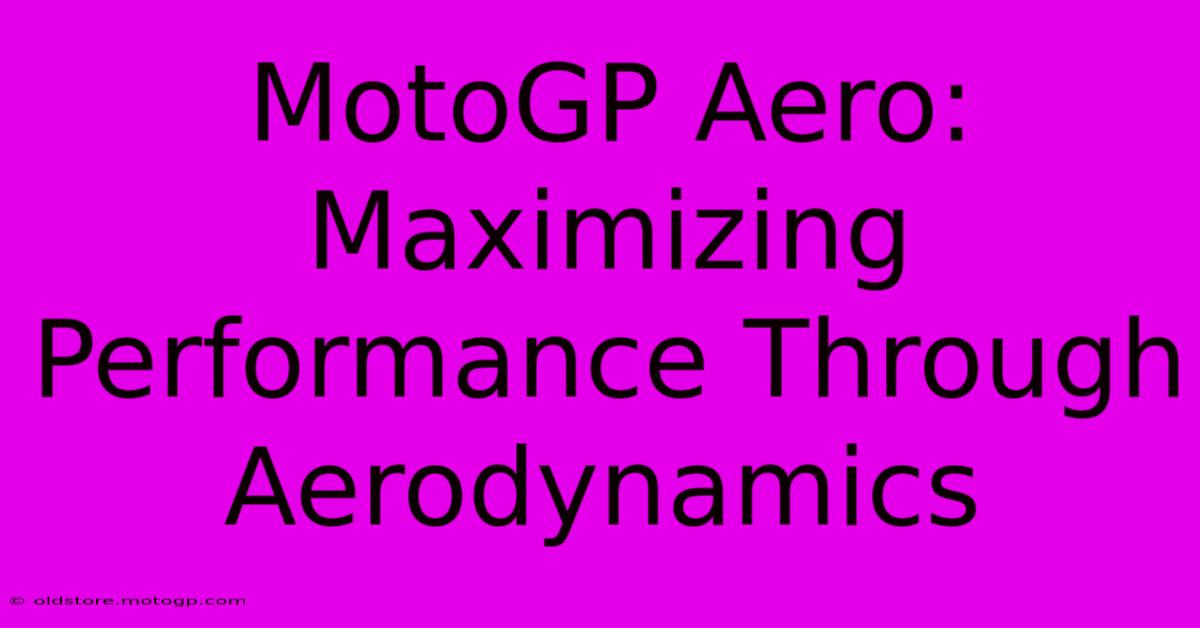MotoGP Aero: Maximizing Performance Through Aerodynamics

Table of Contents
MotoGP Aero: Maximizing Performance Through Aerodynamics
MotoGP, the pinnacle of motorcycle road racing, is a relentless pursuit of speed and performance. Every millisecond counts, and every aspect of the machine is meticulously engineered for optimal efficiency. One increasingly critical area is aerodynamics – the science of manipulating airflow to enhance performance. This article delves into the world of MotoGP aero, exploring how teams harness the power of wind to gain a crucial competitive edge.
The Importance of Aerodynamics in MotoGP
In MotoGP, even small aerodynamic improvements can translate into significant lap time reductions. At high speeds, aerodynamic forces become dominant, influencing stability, braking performance, and ultimately, race results. The bikes, traveling at speeds exceeding 200 mph (320 km/h), generate substantial downforce, crucial for maintaining grip and stability through corners. However, managing drag is equally important, as reducing it directly increases top speed on straights.
Key Aerodynamic Components
Modern MotoGP bikes are marvels of aerodynamic engineering, featuring several key components designed to optimize airflow:
-
Fairings: The sculpted bodywork of the bike is carefully designed to minimize drag and maximize downforce. The shape and surface texture are meticulously refined through Computational Fluid Dynamics (CFD) simulations and wind tunnel testing.
-
Winglets: These small, wing-like structures, typically located on the fairing, generate downforce, improving stability and cornering speed. Their design is constantly evolving, with teams experimenting with different shapes and configurations to find the optimal balance between downforce and drag.
-
Aerodynamic Appendages: Beyond winglets, other aerodynamic aids are employed, such as small fins and spoilers, strategically placed to manage airflow around various parts of the bike. These components are often subtly integrated into the fairing design.
-
Underbody Aerodynamics: The airflow under the bike is also crucial. Teams employ clever underbody designs to create a low-pressure zone, enhancing downforce and stability.
Balancing Downforce and Drag: The Constant Challenge
The challenge for MotoGP engineers lies in finding the optimal balance between downforce and drag. More downforce improves cornering grip, but it also increases drag, reducing top speed. This requires sophisticated simulations and testing to find the sweet spot for each track and racing conditions.
The Role of Data and Simulation
Computational Fluid Dynamics (CFD) software plays a vital role in MotoGP aero development. Teams use CFD to simulate airflow around the bike, allowing them to test various design concepts virtually before building and testing physical prototypes. This significantly reduces development time and cost. Wind tunnel testing remains crucial for validating CFD results and fine-tuning the designs.
The Future of MotoGP Aerodynamics
The pursuit of aerodynamic perfection is an ongoing process in MotoGP. Teams are constantly exploring new materials and designs to push the boundaries of performance. Expect to see even more sophisticated aerodynamic solutions in the future, as teams leverage cutting-edge technology to gain every possible advantage. Active aerodynamics, where aerodynamic components adjust automatically based on speed and track conditions, is a potential area for future development.
Conclusion
Aerodynamics is a critical factor in MotoGP's relentless quest for speed and performance. The constant interplay between downforce and drag, coupled with advancements in CFD and wind tunnel technology, pushes the boundaries of what's possible. The sophisticated aerodynamic solutions employed in MotoGP not only enhance performance on the track but also contribute to a captivating spectacle for fans worldwide. The future of MotoGP aero promises to be as exciting and innovative as the sport itself.

Thank you for visiting our website wich cover about MotoGP Aero: Maximizing Performance Through Aerodynamics. We hope the information provided has been useful to you. Feel free to contact us if you have any questions or need further assistance. See you next time and dont miss to bookmark.
Featured Posts
-
Upgrade Your Ride Ex Factory Race Bikes
Feb 20, 2025
-
Cota Experience The Best Of Austin
Feb 20, 2025
-
Cota Transportation A Comprehensive Guide
Feb 20, 2025
-
Moto Gp Where Speed Meets Extravagance
Feb 20, 2025
-
Your Grand Prix Ride Awaits Book F1 Shuttles Now
Feb 20, 2025
